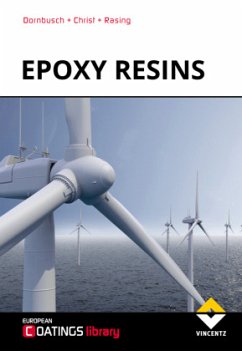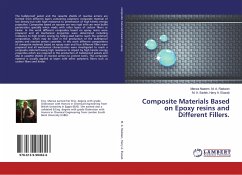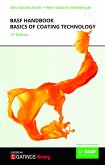- Gebundenes Buch
- Merkliste
- Auf die Merkliste
- Bewerten Bewerten
- Teilen
- Produkt teilen
- Produkterinnerung
- Produkterinnerung
Aufbau, Struktur und Eigenschaften der Epoxidharze werden für lösemittelhaltige als auch für wässrige Systeme in dem neuen Fachbuch Epoxidharze dargestellt. Die 1K- und die 2K-Systeme werden beleuchtet und die lacktechnischen Grundlagen effizient hervorgehoben. Dem Leser werden unterschiedliche Anwendungsmöglichkeiten der Epoxidharzsysteme und deren Vor- und Nachteile nahegebracht. Außerdem verschafft das Buch einen Einblick in anwendungstechnische Anforderungen und deren Überprüfung.
Andere Kunden interessierten sich auch für
![Composite Materials Based on Epoxy resins and Different Fillers. Composite Materials Based on Epoxy resins and Different Fillers.]() M. A. Radwan, Marwa Naeem,Composite Materials Based on Epoxy resins and Different Fillers.36,99 €
M. A. Radwan, Marwa Naeem,Composite Materials Based on Epoxy resins and Different Fillers.36,99 €![Silicone Resins and their Combinations Silicone Resins and their Combinations]() Wernfried HeilenSilicone Resins and their Combinations179,00 €
Wernfried HeilenSilicone Resins and their Combinations179,00 €![BASF Handbook Basics of Coating Technology BASF Handbook Basics of Coating Technology]() Hans-Joachim StreitbergerBASF Handbook Basics of Coating Technology179,00 €
Hans-Joachim StreitbergerBASF Handbook Basics of Coating Technology179,00 €![Design of Experiments for Coatings Design of Experiments for Coatings]() Albert RösslerDesign of Experiments for Coatings189,00 €
Albert RösslerDesign of Experiments for Coatings189,00 €![Synthesis and Characterisation of Polyurethane using Castor Oil Synthesis and Characterisation of Polyurethane using Castor Oil]() Saurabh TaydeSynthesis and Characterisation of Polyurethane using Castor Oil32,99 €
Saurabh TaydeSynthesis and Characterisation of Polyurethane using Castor Oil32,99 €
Aufbau, Struktur und Eigenschaften der Epoxidharze werden für lösemittelhaltige als auch für wässrige Systeme in dem neuen Fachbuch Epoxidharze dargestellt. Die 1K- und die 2K-Systeme werden beleuchtet und die lacktechnischen Grundlagen effizient hervorgehoben. Dem Leser werden unterschiedliche Anwendungsmöglichkeiten der Epoxidharzsysteme und deren Vor- und Nachteile nahegebracht. Außerdem verschafft das Buch einen Einblick in anwendungstechnische Anforderungen und deren Überprüfung.
Produktdetails
- Produktdetails
- European Coatings Library
- Verlag: Vincentz Network
- Artikelnr. des Verlages: 603
- Seitenzahl: 240
- Erscheinungstermin: 11. Mai 2016
- Englisch
- Abmessung: 230mm x 161mm x 20mm
- Gewicht: 600g
- ISBN-13: 9783866308879
- ISBN-10: 3866308876
- Artikelnr.: 44937893
- European Coatings Library
- Verlag: Vincentz Network
- Artikelnr. des Verlages: 603
- Seitenzahl: 240
- Erscheinungstermin: 11. Mai 2016
- Englisch
- Abmessung: 230mm x 161mm x 20mm
- Gewicht: 600g
- ISBN-13: 9783866308879
- ISBN-10: 3866308876
- Artikelnr.: 44937893
Content1 Introduction, Michael Dornbusch1.1 History1.2 Application of epoxide resins 1.2.1 Coating agents1.2.2 Construction materials1.2.3 Adhesions1.3 Terms and market1.3.1 Nomenclature1.3.2 Markets 1.4 Literature2 Basic chemistry of the epoxy group, Michael Dornbusch2.1 Properties and reactions of epoxy groups2.1.1 Reaction with nucleophils2.1.2 Reaction via acid catalyst2.1.3 Properties of the epoxy group2.2 Production and properties of epoxide resins2.2.1 Production and properties of the monomers2.2.1.1 Epichlorohydrin2.2.1.2 Bisphenols2.2.1.3 Epoxides based on olefins2.2.1.4 Glycidyl ester2.2.1.5 Aliphatic glycidyl ether 2.2.2 Production and propterties of the oligomers2.2.2.1 Bisphenol based epoxide resins2.2.2.2 Epoxide-novolaks2.3 Parameters of epoxide resins2.3.1 Epoxy equivalent of epoxy resins2.3.2 OH-Number of epoxy resins2.3.3 Chloride contents of epoxide resins2.3.4 Investigation of the tendency to granulate of liquid resins2.3.5 Detection reactions2.4 Structure and properties of polymers based on epoxide resins and their curing processes2.4.1 Polyether polyol and phenoxy resins2.4.2 Polyether polyol with epoxy groups2.4.2.1 Catalytic curing of epoxide resins2.4.3 Water based epoxide resins2.4.4 Resins for hybrids with polymers based on epoxide resins2.4.4.1 Epoxide acrylate2.4.4.2 Epoxide alkyd, epoxyester2.4.4.3 Epoxide-siloxane/silicone2.4.4.4 Epoxide-polyamidimide2.5 Literature3 Epoxide in coatings3.1 Epoxy groups as cross-linked building blocks, Michael Dornbusch3.1.1 Overview of epoxy resins and hardeners3.1.2 Epoxy groups in UV-curable coating systems3.1.3 Epoxy groups in dip coatings3.2 Protective coatings, Ulrich Christ3.2.1 Industrial coatings3.2.2 Corrosion protection3.3 Applied flooring technology, Rob Rasing3.3.1 Concrete3.3.2 Application of epoxy thermosets for ambient cure condition3.3.3 Floor design and installation3.3.4 Industrial flooring performance attributes3.3.5 High performance industrial flooring3.4 Powder coatings, Ulrich Christ3.4.1 Epoxy powder coatings3.4.1.1 Curing with dicyandiamide (DICY)3.4.1.2 Curing with phenolic resins3.4.1.3 Curing with anhydrides3.4.2 Epoxy polyester powder coatings or hybrid powder coatings3.4.3 Polyester powder coatings3.4.4 Acrylic powder coatings3.5 Can and Coil Coatings, Michael Dornbusch3.5.1 Can Coatings3.5.2 Coil Coating3.6 Literature4 Trends and outlook, Ulrich Christ 4.1 Legal requirements related to health, safety and environmental protection4.2 New product developments4.2.1 Epoxy resins - applicable in future also for topcoats4.2.2 New waterbased 1pack-epoxy technology for high duty corrosion protection systems4.2.3 Improving the corrosion protection of 2pack- epoxy coatings by active anti-corrosion and barrier pigments4.2.4 Trends in epoxy-based powder coatings4.3 Potential replacement of BPA in Can Coatings, Michael Dornbusch4.3.1 BPA replacement with bisphenol derivates4.3.2 BPA replacement with new epoxide compounds4.3.3 BPA replacement with other resins4.4 Epoxides as building blocks for use of anthropogenic carbon dioxide for chemical syntheses, Ulrich Christ4.5 Outlook - a strong growth predicted for epoxy resins4.6 Literature
Content 1 Introduction, Michael Dornbusch 1.1 History 1.2 Application of epoxide resins 1.2.1 Coating agents 1.2.2 Construction materials 1.2.3 Adhesions 1.3 Terms and market 1.3.1 Nomenclature 1.3.2 Markets 1.4 Literature 2 Basic chemistry of the epoxy group, Michael Dornbusch 2.1 Properties and reactions of epoxy groups 2.1.1 Reaction with nucleophils 2.1.2 Reaction via acid catalyst 2.1.3 Properties of the epoxy group 2.2 Production and properties of epoxide resins 2.2.1 Production and properties of the monomers 2.2.1.1 Epichlorohydrin 2.2.1.2 Bisphenols 2.2.1.3 Epoxides based on olefins 2.2.1.4 Glycidyl ester 2.2.1.5 Aliphatic glycidyl ether 2.2.2 Production and propterties of the oligomers 2.2.2.1 Bisphenol based epoxide resins 2.2.2.2 Epoxide-novolaks 2.3 Parameters of epoxide resins 2.3.1 Epoxy equivalent of epoxy resins 2.3.2 OH-Number of epoxy resins 2.3.3 Chloride contents of epoxide resins 2.3.4 Investigation of the tendency to granulate of liquid resins 2.3.5 Detection reactions 2.4 Structure and properties of polymers based on epoxide resins and their curing processes 2.4.1 Polyether polyol and phenoxy resins 2.4.2 Polyether polyol with epoxy groups 2.4.2.1 Catalytic curing of epoxide resins 2.4.3 Water based epoxide resins 2.4.4 Resins for hybrids with polymers based on epoxide resins 2.4.4.1 Epoxide acrylate 2.4.4.2 Epoxide alkyd, epoxyester 2.4.4.3 Epoxide-siloxane/silicone 2.4.4.4 Epoxide-polyamidimide 2.5 Literature 3 Epoxide in coatings 3.1 Epoxy groups as cross-linked building blocks, Michael Dornbusch 3.1.1 Overview of epoxy resins and hardeners 3.1.2 Epoxy groups in UV-curable coating systems 3.1.3 Epoxy groups in dip coatings 3.2 Protective coatings, Ulrich Christ 3.2.1 Industrial coatings 3.2.2 Corrosion protection 3.3 Applied flooring technology, Rob Rasing 3.3.1 Concrete 3.3.2 Application of epoxy thermosets for ambient cure condition 3.3.3 Floor design and installation 3.3.4 Industrial flooring performance attributes 3.3.5 High performance industrial flooring 3.4 Powder coatings, Ulrich Christ 3.4.1 Epoxy powder coatings 3.4.1.1 Curing with dicyandiamide (DICY) 3.4.1.2 Curing with phenolic resins 3.4.1.3 Curing with anhydrides 3.4.2 Epoxy polyester powder coatings or hybrid powder coatings 3.4.3 Polyester powder coatings 3.4.4 Acrylic powder coatings 3.5 Can and Coil Coatings, Michael Dornbusch 3.5.1 Can Coatings 3.5.2 Coil Coating 3.6 Literature 4 Trends and outlook, Ulrich Christ 4.1 Legal requirements related to health, safety and environmental protection 4.2 New product developments 4.2.1 Epoxy resins - applicable in future also for topcoats 4.2.2 New waterbased 1pack-epoxy technology for high duty corrosion protection systems 4.2.3 Improving the corrosion protection of 2pack- epoxy coatings by active anti-corrosion and barrier pigments 4.2.4 Trends in epoxy-based powder coatings 4.3 Potential replacement of BPA in Can Coatings, Michael Dornbusch 4.3.1 BPA replacement with bisphenol derivates 4.3.2 BPA replacement with new epoxide compounds 4.3.3 BPA replacement with other resins 4.4 Epoxides as building blocks for use of anthropogenic carbon dioxide for chemical syntheses, Ulrich Christ 4.5 Outlook - a strong growth predicted for epoxy resins 4.6 Literature
Content1 Introduction, Michael Dornbusch1.1 History1.2 Application of epoxide resins 1.2.1 Coating agents1.2.2 Construction materials1.2.3 Adhesions1.3 Terms and market1.3.1 Nomenclature1.3.2 Markets 1.4 Literature2 Basic chemistry of the epoxy group, Michael Dornbusch2.1 Properties and reactions of epoxy groups2.1.1 Reaction with nucleophils2.1.2 Reaction via acid catalyst2.1.3 Properties of the epoxy group2.2 Production and properties of epoxide resins2.2.1 Production and properties of the monomers2.2.1.1 Epichlorohydrin2.2.1.2 Bisphenols2.2.1.3 Epoxides based on olefins2.2.1.4 Glycidyl ester2.2.1.5 Aliphatic glycidyl ether 2.2.2 Production and propterties of the oligomers2.2.2.1 Bisphenol based epoxide resins2.2.2.2 Epoxide-novolaks2.3 Parameters of epoxide resins2.3.1 Epoxy equivalent of epoxy resins2.3.2 OH-Number of epoxy resins2.3.3 Chloride contents of epoxide resins2.3.4 Investigation of the tendency to granulate of liquid resins2.3.5 Detection reactions2.4 Structure and properties of polymers based on epoxide resins and their curing processes2.4.1 Polyether polyol and phenoxy resins2.4.2 Polyether polyol with epoxy groups2.4.2.1 Catalytic curing of epoxide resins2.4.3 Water based epoxide resins2.4.4 Resins for hybrids with polymers based on epoxide resins2.4.4.1 Epoxide acrylate2.4.4.2 Epoxide alkyd, epoxyester2.4.4.3 Epoxide-siloxane/silicone2.4.4.4 Epoxide-polyamidimide2.5 Literature3 Epoxide in coatings3.1 Epoxy groups as cross-linked building blocks, Michael Dornbusch3.1.1 Overview of epoxy resins and hardeners3.1.2 Epoxy groups in UV-curable coating systems3.1.3 Epoxy groups in dip coatings3.2 Protective coatings, Ulrich Christ3.2.1 Industrial coatings3.2.2 Corrosion protection3.3 Applied flooring technology, Rob Rasing3.3.1 Concrete3.3.2 Application of epoxy thermosets for ambient cure condition3.3.3 Floor design and installation3.3.4 Industrial flooring performance attributes3.3.5 High performance industrial flooring3.4 Powder coatings, Ulrich Christ3.4.1 Epoxy powder coatings3.4.1.1 Curing with dicyandiamide (DICY)3.4.1.2 Curing with phenolic resins3.4.1.3 Curing with anhydrides3.4.2 Epoxy polyester powder coatings or hybrid powder coatings3.4.3 Polyester powder coatings3.4.4 Acrylic powder coatings3.5 Can and Coil Coatings, Michael Dornbusch3.5.1 Can Coatings3.5.2 Coil Coating3.6 Literature4 Trends and outlook, Ulrich Christ 4.1 Legal requirements related to health, safety and environmental protection4.2 New product developments4.2.1 Epoxy resins - applicable in future also for topcoats4.2.2 New waterbased 1pack-epoxy technology for high duty corrosion protection systems4.2.3 Improving the corrosion protection of 2pack- epoxy coatings by active anti-corrosion and barrier pigments4.2.4 Trends in epoxy-based powder coatings4.3 Potential replacement of BPA in Can Coatings, Michael Dornbusch4.3.1 BPA replacement with bisphenol derivates4.3.2 BPA replacement with new epoxide compounds4.3.3 BPA replacement with other resins4.4 Epoxides as building blocks for use of anthropogenic carbon dioxide for chemical syntheses, Ulrich Christ4.5 Outlook - a strong growth predicted for epoxy resins4.6 Literature
Content 1 Introduction, Michael Dornbusch 1.1 History 1.2 Application of epoxide resins 1.2.1 Coating agents 1.2.2 Construction materials 1.2.3 Adhesions 1.3 Terms and market 1.3.1 Nomenclature 1.3.2 Markets 1.4 Literature 2 Basic chemistry of the epoxy group, Michael Dornbusch 2.1 Properties and reactions of epoxy groups 2.1.1 Reaction with nucleophils 2.1.2 Reaction via acid catalyst 2.1.3 Properties of the epoxy group 2.2 Production and properties of epoxide resins 2.2.1 Production and properties of the monomers 2.2.1.1 Epichlorohydrin 2.2.1.2 Bisphenols 2.2.1.3 Epoxides based on olefins 2.2.1.4 Glycidyl ester 2.2.1.5 Aliphatic glycidyl ether 2.2.2 Production and propterties of the oligomers 2.2.2.1 Bisphenol based epoxide resins 2.2.2.2 Epoxide-novolaks 2.3 Parameters of epoxide resins 2.3.1 Epoxy equivalent of epoxy resins 2.3.2 OH-Number of epoxy resins 2.3.3 Chloride contents of epoxide resins 2.3.4 Investigation of the tendency to granulate of liquid resins 2.3.5 Detection reactions 2.4 Structure and properties of polymers based on epoxide resins and their curing processes 2.4.1 Polyether polyol and phenoxy resins 2.4.2 Polyether polyol with epoxy groups 2.4.2.1 Catalytic curing of epoxide resins 2.4.3 Water based epoxide resins 2.4.4 Resins for hybrids with polymers based on epoxide resins 2.4.4.1 Epoxide acrylate 2.4.4.2 Epoxide alkyd, epoxyester 2.4.4.3 Epoxide-siloxane/silicone 2.4.4.4 Epoxide-polyamidimide 2.5 Literature 3 Epoxide in coatings 3.1 Epoxy groups as cross-linked building blocks, Michael Dornbusch 3.1.1 Overview of epoxy resins and hardeners 3.1.2 Epoxy groups in UV-curable coating systems 3.1.3 Epoxy groups in dip coatings 3.2 Protective coatings, Ulrich Christ 3.2.1 Industrial coatings 3.2.2 Corrosion protection 3.3 Applied flooring technology, Rob Rasing 3.3.1 Concrete 3.3.2 Application of epoxy thermosets for ambient cure condition 3.3.3 Floor design and installation 3.3.4 Industrial flooring performance attributes 3.3.5 High performance industrial flooring 3.4 Powder coatings, Ulrich Christ 3.4.1 Epoxy powder coatings 3.4.1.1 Curing with dicyandiamide (DICY) 3.4.1.2 Curing with phenolic resins 3.4.1.3 Curing with anhydrides 3.4.2 Epoxy polyester powder coatings or hybrid powder coatings 3.4.3 Polyester powder coatings 3.4.4 Acrylic powder coatings 3.5 Can and Coil Coatings, Michael Dornbusch 3.5.1 Can Coatings 3.5.2 Coil Coating 3.6 Literature 4 Trends and outlook, Ulrich Christ 4.1 Legal requirements related to health, safety and environmental protection 4.2 New product developments 4.2.1 Epoxy resins - applicable in future also for topcoats 4.2.2 New waterbased 1pack-epoxy technology for high duty corrosion protection systems 4.2.3 Improving the corrosion protection of 2pack- epoxy coatings by active anti-corrosion and barrier pigments 4.2.4 Trends in epoxy-based powder coatings 4.3 Potential replacement of BPA in Can Coatings, Michael Dornbusch 4.3.1 BPA replacement with bisphenol derivates 4.3.2 BPA replacement with new epoxide compounds 4.3.3 BPA replacement with other resins 4.4 Epoxides as building blocks for use of anthropogenic carbon dioxide for chemical syntheses, Ulrich Christ 4.5 Outlook - a strong growth predicted for epoxy resins 4.6 Literature





